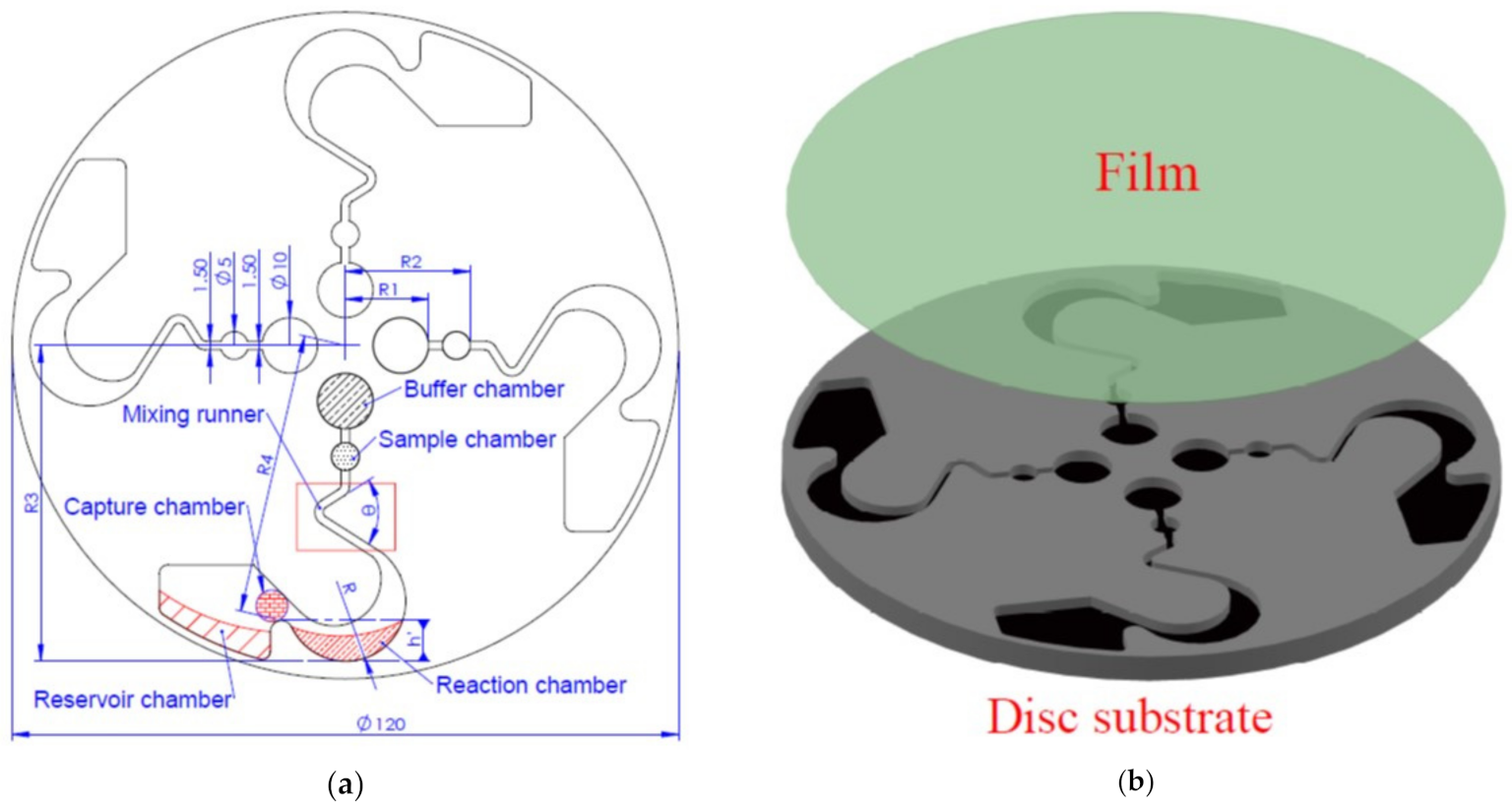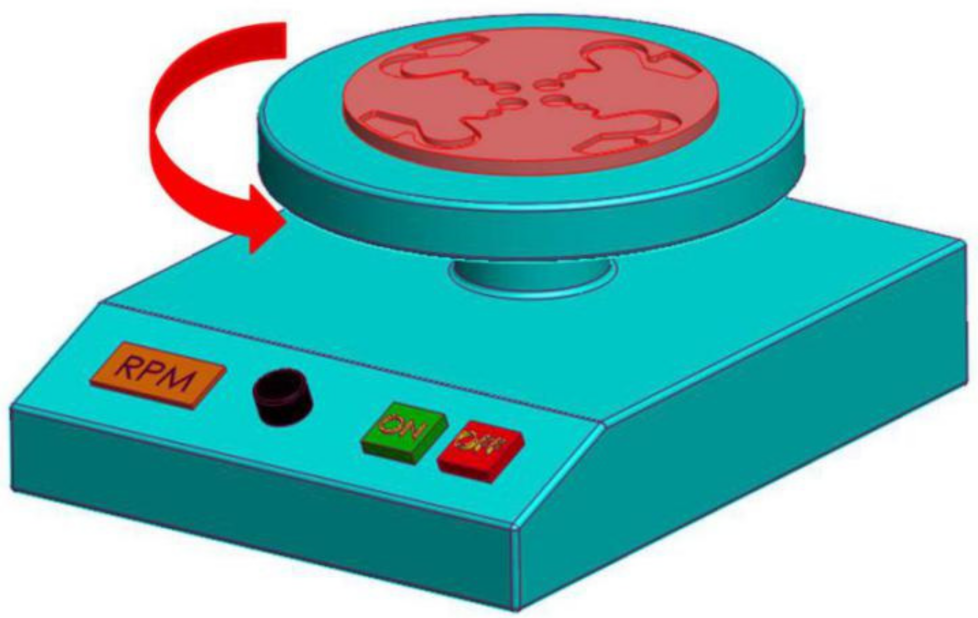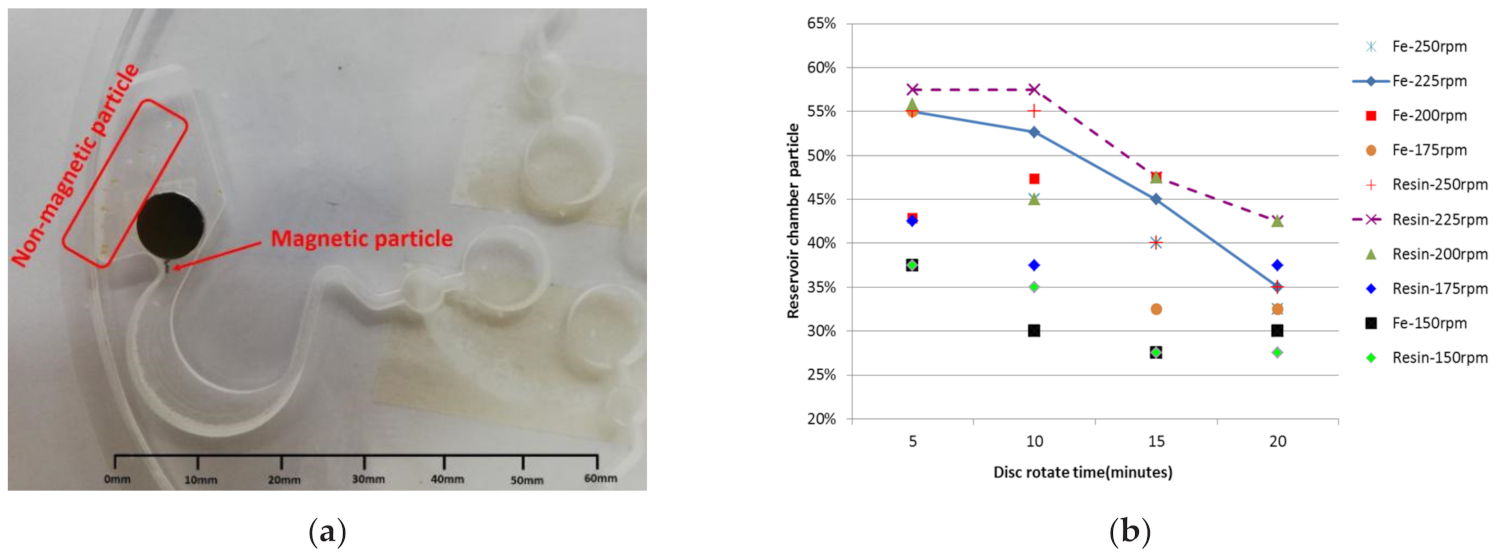How to Control the Microfluidic Flow and Separate the Magnetic and Non-Magnetic Particles in the Runner of a Disc
Abstract
:1. Introduction
2. Research Procedure and Methods
2.1. Design the Pattern of the Disc
2.2. Theory
2.3. Simulation Method
2.4. Experimental Method
3. Simulation and Experimental Result
3.1. Optimal Pattern Design and Rotating Mode of the Centrifugal Disc by Simulation
3.1.1. Optimal Mixing Runner Design
3.1.2. Optimal Rotating Mode Setting of the Disc by Simulation
3.2. The Experimental of Flowing and Sorting in the Centrifugal Disc for Magnetic and Non-Magnetic Particles
4. Conclusions and Future Work
Author Contributions
Funding
Institutional Review Board Statement
Informed Consent Statement
Conflicts of Interest
References
- Huang, L.; Zhao, P.; Bian, S.; Shi, G.; Liu, P.; Zong, S.; Wang, W. A novel BioMEMS device for efficient on-chip single cell loading and 3D rotation. In Proceedings of the 2017 IEEE 30th International Conference on Micro Electro Mechanical Systems (MEMS), Las Vegas, NV, USA, 22–26 January 2017; pp. 490–493. [Google Scholar]
- El Hassani, N.E.A.; Baraket, A.; Neto, E.T.T.; Lee, M.; Salvador, J.P.; Marco, M.P.; Bausells, J.; El Bari, N.; Bouchikhi, B.; Elaissari, A.; et al. Novel strategy for sulfapyridine detection using a fully integrated electrochemical Bio-MEMS: Application to honey analysis. Biosens. Bioelectron. 2017, 93, 282–288. [Google Scholar] [CrossRef] [PubMed]
- Strohmeier, O.; Keller, M.; Schwemmer, F.; Zehnle, S.; Mark, D.; von Stetten, F.; Zengerle, R.; Paust, N. Centrifugal microfluidic platforms: Advanced unit operations and applications. Chem. Soc. Rev. 2015, 44, 6187–6229. [Google Scholar] [CrossRef] [PubMed] [Green Version]
- Hou, J.-M.; Greystoke, A.; Lancashire, L.; Cummings, J.; Ward, T.; Board, R.; Amir, E.; Hughes, S.; Krebs, M.; Hughes, A.; et al. Evaluation of circulating tumor cells and serological cell death biomarkers in small cell lung cancer patients undergoing chemotherapy. Am. J. Pathol. 2009, 175, 808–816. [Google Scholar] [CrossRef] [PubMed] [Green Version]
- Hajba, L.; Guttman, A. Circulating tumor-cell detection and capture using microfluidic devices. TrAC Trends Anal. Chem. 2014, 59, 9–16. [Google Scholar] [CrossRef] [Green Version]
- Millner, L.M.; Linder, M.W.; Valdes, R. Circulating tumor cells: A review of present methods and the need to identify heterogeneous phenotypes. Ann. Clin. Lab. Sci. 2013, 43, 295–304. [Google Scholar]
- Tang, M.; Wang, G.; Kong, S.K.; Ho, H.P. A review of biomedical centrifugal microfluidic platforms. Micromachines 2016, 7, 26. [Google Scholar] [CrossRef] [PubMed] [Green Version]
- Ruffert, C. Magnetic bead—Magic bullet. Micromachines 2016, 7, 21. [Google Scholar] [CrossRef] [Green Version]
- Zborowski, M.; Chalmers, J.J. Rare cell separation and analysis by magnetic sorting. Anal. Chem. 2011, 83, 8050–8056. [Google Scholar] [CrossRef] [PubMed] [Green Version]
- Oh, S.; Jung, S.H.; Seo, H.; Min, M.-K.; Kim, B.; Hahn, Y.K.; Kang, J.H.; Choi, S. Magnetic activated cell sorting (MACS) pipette tip for immunomagnetic bacteria separation. Sens. Actuators B Chem. 2018, 272, 324–330. [Google Scholar] [CrossRef]
- Uddin, R.; Donolato, M.; Hwu, E.T.; Hansen, M.F.; Boisen, A. Combined detection of C-reactive protein and PBMC quantification from whole blood in an integrated lab-on-a-disc microfluidic platform. Sens. Actuators B Chem. 2018, 272, 634–642. [Google Scholar] [CrossRef]
- Arjmand, E.M.; Saadatmand, M.; Bakhtiari, M.R.; Eghbal, M.; Balaei, A. A Centrifugal Microfluidic Platform to Measure Hemoglobin of Whole Blood. In Proceedings of the 24th National and 2nd International Iranian Conference on Biomedical Engineering (ICBME), Tehran, Iran, 30 November–1 December 2017; pp. 330–333. [Google Scholar]
- Fakhari, S.; Pishbin, E.; Navibakhsh, M.; Maghazeh, M.; Eghbal, M. Implementing series of dual-chamber units for sequential loading of the liquids in centrifugal microfluidic platforms. Microfluid. Nanofluid. 2019, 23, 53. [Google Scholar] [CrossRef]
- Aeinehvand, M.M.; Weber, L.; Jiménez, M.; Palermo, A.; Bauer, M.; Loeffler, F.F.; Ibrahim, F.; Breitling, F.; Korvink, J.; Madou, M.; et al. Elastic reversible valves on centrifugal microfluidic platforms. Lab Chip 2019, 19, 1090–1100. [Google Scholar] [CrossRef] [PubMed]
- Korkusuz, P.; Köse, S.; Yersal, N.; Önen, S. Magnetic-based cell isolation technique for the selection of stem cells. In Skin Stem Cells; Humana Press: New York, NY, USA, 2018; pp. 153–163. [Google Scholar]
- Cai, G.; Xue, L.; Zhang, H.; Lin, J. A review on micromixers. Micromachines 2017, 8, 274. [Google Scholar] [CrossRef]
- Sayad, A.; Ibrahim, F.; Uddin, S.M.; Cho, J.; Madou, M.; Thong, K.L. A microdevice for rapid, monoplex and colorimetric detection of foodborne pathogens using a centrifugal microfluidic platform. Biosens. Bioelectron. 2018, 100, 96–104. [Google Scholar] [CrossRef]
- Zehnle, S.; Schwemmer, F.; Bergmann, R.; von Stetten, F.; Zengerle, R.; Paust, N. Pneumatic siphon valving and switching in centrifugal microfluidics controlled by rotational frequency or rotational acceleration. Microfluid. Nanofluid. 2015, 19, 1259–1269. [Google Scholar] [CrossRef]
- Thio, T.H.G.; Soroori, S.; Ibrahim, F.; Al-Faqheri, W.; Soin, N.; Kulinsky, L.; Madou, M. Theoretical development and critical analysis of burst frequency equations for passive valves on centrifugal microfluidic platforms. Med. Biol. Eng. Comput. 2013, 51, 525–535. [Google Scholar] [CrossRef] [PubMed] [Green Version]
- Nivedita, N.; Ligrani, P.; Papautsky, I. Dean flow dynamics in low-aspect ratio spiral microchannels. Sci. Rep. 2017, 7, 44072. [Google Scholar] [CrossRef] [PubMed] [Green Version]
- Ulkir, O.; Girit, O.; Ertugrul, I. Design and Analysis of a Laminar Diffusion-Based Micromixer with Microfluidic Chip. J. Nanomater. 2021, 2021, 6684068. [Google Scholar] [CrossRef]
- Zhang, L.; Tian, F.; Liu, C.; Feng, Q.; Ma, T.; Zhao, Z.; Li, T.; Jiang, X.; Sun, J. Hand-powered centrifugal microfluidic platform inspired by the spinning top for sample-to-answer diagnostics of nucleic acids. Lab Chip 2018, 18, 610–619. [Google Scholar] [CrossRef] [PubMed]
- Maheshwari, N.; Chatterjee, G.; Rao, V.R. A technology overview and applications of bio-MEMS. J. ISSS 2014, 3, 39–59. [Google Scholar]







| Items | Volume |
|---|---|
| Buffer liquid | 157.0 μL |
| Sample liquid | 39.0 μL |
| Items | Value |
|---|---|
| Buffer flow density/viscosity. | 998.2 kg/cm3/0.001003 kg/m∙s |
| Sample flow density/viscosity. | 1060 kg/cm3/0.003 kg/m∙s |
| Disc rotating angular velocity at the first setting mode | Constant 100 rpm, 200 rpm/3 min |
| Disc rotating angular velocity at the second setting mode | Constant 250 rpm/5 min |
| Items | Value |
|---|---|
| Buffer chamber scale | ψ10 mm × h 2.0 mm |
| Sample chamber scale | ψ5 mm × h 2.0 mm |
| Mixing runner cure angle θ | 60° |
| The magnet scale | ψ10 × 2.0 mm/800 Gauss |
| Rotating speed in the first mode of the disc | Constant 175 rpm to 200 rpm/3 min. |
| Rotating speed in the second mode of the disc | Constant 225 rpm/5~10 min. |
Publisher’s Note: MDPI stays neutral with regard to jurisdictional claims in published maps and institutional affiliations. |
© 2021 by the authors. Licensee MDPI, Basel, Switzerland. This article is an open access article distributed under the terms and conditions of the Creative Commons Attribution (CC BY) license (https://creativecommons.org/licenses/by/4.0/).
Share and Cite
Lin, Y.-T.; Huang, C.-S.; Tseng, S.-C. How to Control the Microfluidic Flow and Separate the Magnetic and Non-Magnetic Particles in the Runner of a Disc. Micromachines 2021, 12, 1335. https://doi.org/10.3390/mi12111335
Lin Y-T, Huang C-S, Tseng S-C. How to Control the Microfluidic Flow and Separate the Magnetic and Non-Magnetic Particles in the Runner of a Disc. Micromachines. 2021; 12(11):1335. https://doi.org/10.3390/mi12111335
Chicago/Turabian StyleLin, Yao-Tsung, Chien-Sheng Huang, and Shi-Chang Tseng. 2021. "How to Control the Microfluidic Flow and Separate the Magnetic and Non-Magnetic Particles in the Runner of a Disc" Micromachines 12, no. 11: 1335. https://doi.org/10.3390/mi12111335
APA StyleLin, Y.-T., Huang, C.-S., & Tseng, S.-C. (2021). How to Control the Microfluidic Flow and Separate the Magnetic and Non-Magnetic Particles in the Runner of a Disc. Micromachines, 12(11), 1335. https://doi.org/10.3390/mi12111335






